This has been yet again a busy week at the Centre, Dr Diane Heath is putting together her revised application to the HLF for her ‘Medieval Animals’ project, Dr Claire Bartram gave an online lecture to the Canterbury Historical and Archaeological Society yesterday evening, see report below, and I am giving one of the talks at the free CHAS Centenary online conference this coming Canterbury, see below for details including the joining url. Moreover, yesterday was the penultimate Lunch Time Lecture, also see below, as well as a meeting of the Kent History Postgraduates group – report next week.
Before I get to the report on yesterday’s two lectures, I thought I would provide details of the last Lunch Time Lecture in this series, and then the CHAS Centenary conference this Saturday. If you haven’t caught the Lunch Time Lectures yet, they are a joint venture between the Friends of Canterbury Cathedral, the Centre for Kent History and Heritage at CCCU, and the Canterbury Association of Medieval and Early Modern Studies (CAMEMS) with MEMS at Kent to showcase the work of postgraduate research in Canterbury.
So next Wednesday at 1pm it will be Anna-Nadine Pike who will be exploring ‘Textures of devotion: Using textile imagery as a stimulus for meditation in the fifteenth-century English writings of St Bridget of Sweden’. This lecture will draw on Anna’s MA dissertation for the MEMS Taught Masters at the University of Kent where she considered the interrelation of text and textiles in late-medieval Middle English Bridgettine writings associated with Syon Abbey. In addition, Anna has interests in the role of performative language in late-medieval mystical writings, and the value of silence and blank space in manuscripts. She is currently a Graduate Trainee in the Library of New College, Oxford.
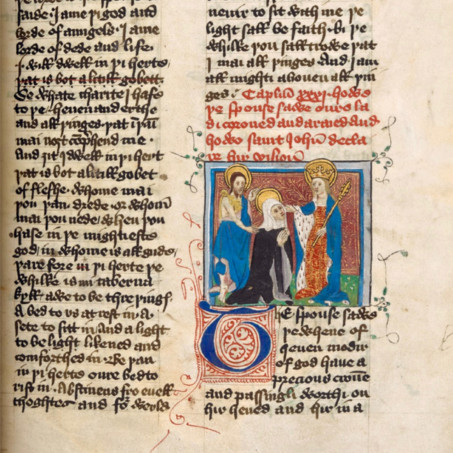
As before, this will be online through Microsoft Teams Live Event and is free to join, no booking required. Please join about 5 to 10 minutes before start time – see joining url below: to join Teams (as you would for Zoom) click on the link or paste in your web browser. Then on the screen click on ‘Open Microsoft Teams’ (centre, top in the little panel, not the buttons in the middle of the screen). Then to get you into the lecture as an attendee click ‘Join now’ (as you would for Zoom). If it asks for your CCCU login, shut down, start again and come in via the web anonymously. This is usually sufficient for it to work, but if after a couple of times doing this you still cannot access as an attendee, please contact the CCCU IT Helpdesk on 01227 922626 (weekday office hours only) or email it-service@canterbury.ac.uk
Now to the CHAS Centenary half-day conference this Saturday ‘Canterbury through the Centuries’, also free and also on Teams Live Events, this is another collaborative venture involving the Centre (CKHH). The online conference will start at 10.00, thus joining 5 or so minutes before is a good idea and as above, although I don’t think the IT helpdesk functions at weekends. If you aren’t sure, give them a call tomorrow or Friday. The joining url is here:
I think I’ll just give you the titles and speakers here to give you some idea of what is in store on Saturday. Working chronologically, I’ll open with Famine and Feast: changing fortunes in 1320 and 1420 to be followed by Dr Stuart Palmer, whom some of you may remember from the book launch of Dr Claire Bartram’s edited collection, Kentish Book Culture. Stuart will be taking the next ’20 date and his title is: 1520 Canterbury: Turbulence, Transition and Tents. Then after a short break, we will move to Stuart and modern times, our first speaker being Dr Lorraine Flisher, who similarly contributed to Claire’s edited book and this time Lorraine will be speaking on: Robert Cushman and The Mayflower 1620: Saints or Sinners? A Revisionist Interpretation of the Mayflower legacy. Finally, and skipping 1720 and 1820, Dr David Budgen from CCCU has as his title Good-bye to all that?: Canterbury in 1920. Ann Chadwick, the chairperson from CHAS will be chairing one of the sessions and will provide the ‘Concluding remarks’, the conference is due to finish at 1pm. Please do join us if you would like to, again booking not required.

I’ll now turn to Jacqueline Stamp’s fascinating lecture yesterday lunch time, where she explored perceptions of the Arctic in the early 19th century, the middle years of the century, and around the year 1900 to demonstrate how attitudes came full circle, from very different ideas mid-century. To begin, she pointed out that with the defeat of the French, the Royal Navy, like the army no longer needed its armed forces and while it was seen as perfectly reasonable to make sailors redundant, naval officers were placed on furlough of half pay. This was seen as an expensive waste of manpower and to find them a useful outlet the Admiralty embarked on a campaign to send expeditions to the North Pole and to look for the North-West Passage. These expeditions fired the imagination because those taking part recorded their stories and the idea of the journey in instalments, of moving forward, might be said to have much in common with later 20th-century expeditions to the moon – a place in some ways familiar, but in other ways totally alien.
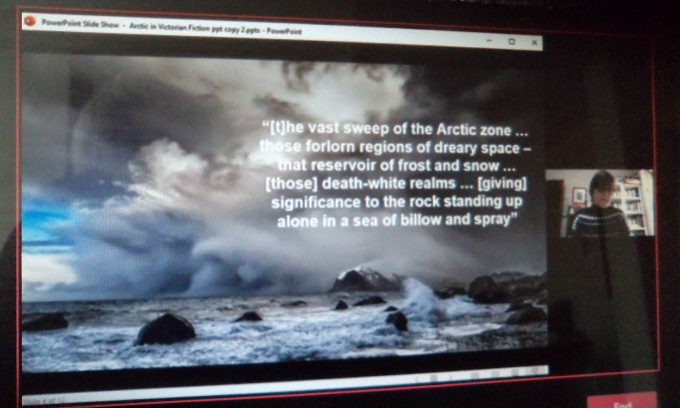
Much of the early literature for around 1820 brought the idea of going forward fearlessly into this wilderness, yet at the same time it required characteristics of patience and endurance, a place that brought isolation with trials and tribulation for those who ventured north. Among those who deployed such ideas was Charlotte Bronte in Jane Eyre, who talked about the idea of the dreariness of this isolation, as well as the sheer vastness of this land of frost and snow. Nor was she alone, because Mary Shelley drew on similar vocabulary to invoke the sense of beauty of such a wilderness that was juxtaposed to a ‘reality’ of frost and desolation.
Someone whom I had not come across before was John Cleves Symmes, another writer from this early period whose hollow Earth theory drew on Norse folklore traditions with the idea that this other world within the Earth that could be entered from the poles. This offered another way to see the polar region as one of deadly ice fields, which again could be deployed to play into the popular imagination of the time.
Such ideas would largely resurface again in the novels of Thomas Hardy, such as Tess of the d’Urbervilles in 1891, where even though Tess is not set in the Arctic, the Arctic weather comes to her, requiring the same characteristics of endurance to such hardships in the face of the bitter cold. Interestingly, Hardy did not confine his agents of such icy blasts to weather features, but also drew on the idea of Arctic animals as actors, including polar bears and whales, which for his audience would have been synonymous with the polar regions.
Yet, if these were the representations employed by writers at the beginning and the end of the Victorian era, during the middle years the Arctic became a place of sentimentality, a sacred land that drew out solidly Christian morality from its middle-class audience that was increasingly becoming a major part of the reading public. Nor, as Jacquie pointed out, were such ideas seen as appropriate solely for an adult audience, and children’s literature such as The Snow Queen and At the Back of the North Wind offered moral messages as well as capturing the innocence of the Arctic as an enchanted land. – a place of pure and noble thoughts.
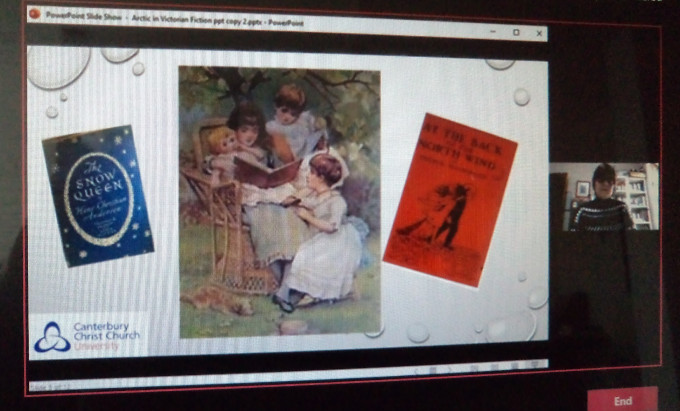
Another arena provided by the Arctic was as a place of opportunity and adventure, when placed in the hands of writes such as Jules Verne and Arthur Conan Doyle. A book like Peter the Whaler offered a tremendous sense of adventure as Peter overcomes one disaster after another, but all though such tribulations he retained gentlemanly virtues alongside his courage. For by so doing, heroes overcame tests of character, could highlight British superiority and deploy concepts of empire. Of course, such writers had valuable examples to draw on, even if or sometimes because of their failure to conqueror the Arctic. Probably the best known is Sir John Franklin whose third expedition to find the North-West Passage led to his death and the deaths of all involved. Moreover, his wife’s dogged determination to send out expeditions to find him, and that once finally found items became something almost of veneration, again demonstrates how the Arctic had become intertwined with English values.
Now an exploration of Victorian literature would not be complete without Dickens, so I’ll confine him to my final point. As you might expect, Dickens understood the value of the Arctic, including in his weekly journal Household Words the story of ‘The Wreck of the Golden Mary’ where he wrote the first instalment, the story continued by writers such as Wilkie Collins and James White. Moreover, and here I’m returning to Franklin, it was not just novels that drew on notions of the Arctic because Collins and Dickens were also responsible for ‘The Frozen Deep’, a play that drew on Franklin’s ill-fated last expedition for its story, as well as what might be seen as the moral superiority underlying it.
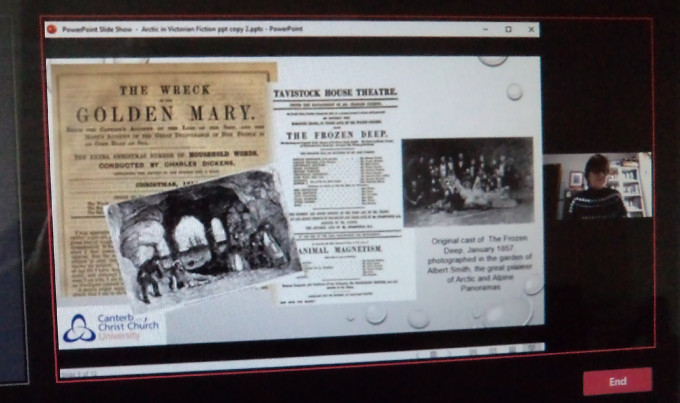
Jacquie explored other matters too, including a survey of the differences between boys and girls reading habits from the mid-century, which provides a fascinating snapshot from this period. And like all great papers, it drew a considerable number of questions from the audience of between twenty-five and thirty people. Thus, thanks are very much due to Jacquie for a terrific lecture, to Diane Heath as producer and to Toby Charlton-Taylor for again providing IT support.
I now want to turn briefly to Claire Bartram’s lecture for CHAS in their monthly winter programme. As Claire said at the beginning, the Centre is very grateful for the research grant received from CHAS in 2020, which is important for the ‘Kentish Saints and Martyrs’ exhibition and series of talks that will be re-scheduled for later this year, probably in September – more details in due course.
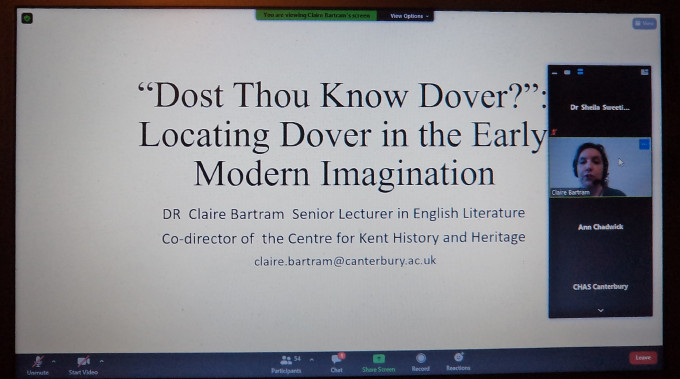
For her talk, Claire had chosen to look at representations of Dover in mainly Elizabethan texts by both those of the town and those outside. Claire explored three case studies, the manuscript created by John Tooke about the history and development of Dover harbour, the role of ritual and drama in the life of Dover for this same period and into the early 17th century, and finally literary pieces primarily from those outside Dover and what they saw and used as markers of Dover – the white cliffs, the pier, the harbour, but not the castle.
Tooke’s manuscript is divided into sections, but unlike such compilations, he sought to bridge between one section and another. Starting with a discourse on the ancient history of the harbour, drawn from important chronicles and other evidence, including the town accounts, Tooke provided a backdrop for his sections that sought to show how and why the new harbour should be constructed as he saw it. For this he employed the idea of a dialogue between protagonists: Reason and Opinion; London and Dover, and Tooke and the Lord Lieutenant of Dover Castle. Thus in his writings he utilised different discourses, in part for his different audiences, but also to strengthen the case he was arguing throughout. This means he used narrative history of others and his own, and for the latter he drew on Dover’s landscape and the people around him, including his own house and the flowers that grow in the shingle bank. Similarly, he deployed the testimony of Dover’s ancient citizens, a trope often found in church courts to highlight time-honoured ideas and the sense of authenticity and antiquity.

For his discourses he employed other forms of writing, seeing these as closer to the narratives provided in courts through the testimony of deponents whose words were in a sense crafted into a narrative that was likely to be contested by others. For Tooke, who had come to Dover from Hythe and who in the decades either side of 1600 would be a prominent civic officer in the town, such court narratives would have been familiar, and therefore, he was capable of following such a format. Through his writings he was able to display his literate skill set, the mark, presumably, of grammar schooling rather than that of a university training. This type and level of education is compatible with the town clerks discussed by Andrew Butcher and Dr Justin Croft for the medieval Cinque Ports.
Moving on to the role of drama in Dover through an assessment of the REED volumes for the diocese of Canterbury by Dr James Gibson, Claire highlighted how Kent was exceptional in terms of the level of pre-Reformation drama that took place across the county. Moreover, towns such as the Cinque Ports were highly important in this community-led drama, and the players from a range of towns frequently visited other towns and villages to perform their biblical or saint’s plays. Furthermore, this seems to have crossed the religious divide in the sense that civic ritual as performance remained a valued part of civic identity. And returning to Tooke, his life as a civic officer would have brought him into such dramatic settings, including the annual ceremonies such as mayor-making, and special occasions such as the proclamation regarding James I coronation.
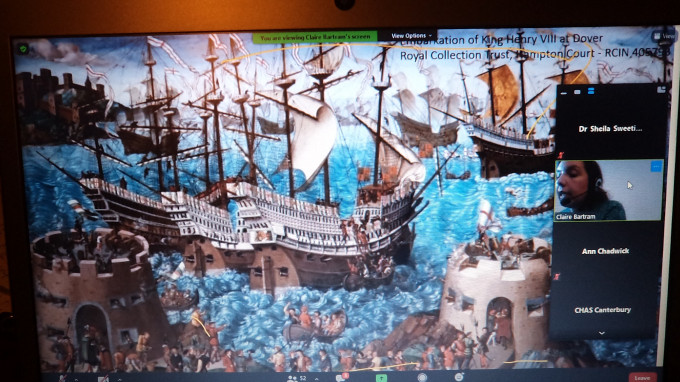
This brings me to Claire’s third case study – what ‘outsiders’ thought of Dover and how they wrote about the town. An article on this will be coming out later this year in Maritime Kent through the Ages, so I’ll just mention a couple of points. Firstly, to try to understand such perceptions, it is vital to draw not only on texts but also maps, such pictorial representations may indeed purport to show reality, but some were aspirational, especially when they related to the harbour.
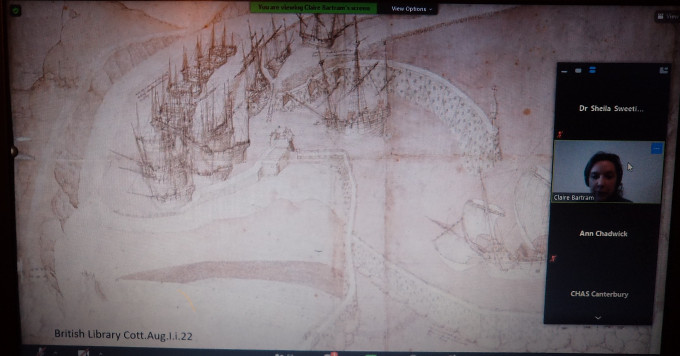
Finally, the motifs that writers seen to have picked on were not the castle, but the pier, the shingle (to a degree), the cliffs, Dover’s hospitality, and, of course, the sea – coming and going, the sense of liminality, of dangers and uncertainty. Of course, there is Shakespeare’s King Lear, but other authors such as Dryden and the less well-known John Taylor offer valuable clues about Dover’s meaning inside and outside the town. Like Jacquie, Claire’s paper generated interesting questions from the audience, the evening ending with Ann Chadwick thanking Claire for her fascinating exploration of literary Dover.
And for next week, I’ll bring you the CHAS conference and the Kent History Postgraduates.
 Centre for Kent History and Heritage
Centre for Kent History and Heritage Sheila Sweetinburgh
Sheila Sweetinburgh 2252
2252


Brilliant blog presentation. Thank you Sheila
Thanks Rama, delighted to hear that you enjoyed the report on Jacquie’s and Claire’s talks.
Best wishes, Sheila
Hi, it would be helpful for people ‚hitting‘ the blog by chance if the announcement of a talk could include a precise date instead of ‚next Wednesday‘. These are really interesting topics and giving a date will be helpful to forward planning.
Thank you
Hello Henny, thanks for your helpful point, although the date of publication of the blog is available so it would be easy to work out the date. I’m delighted to hear that you find the topics interesting. I hope now that you have found the Centre’s blog you will come back again for the weekly blogs. Best wishes, Sheila